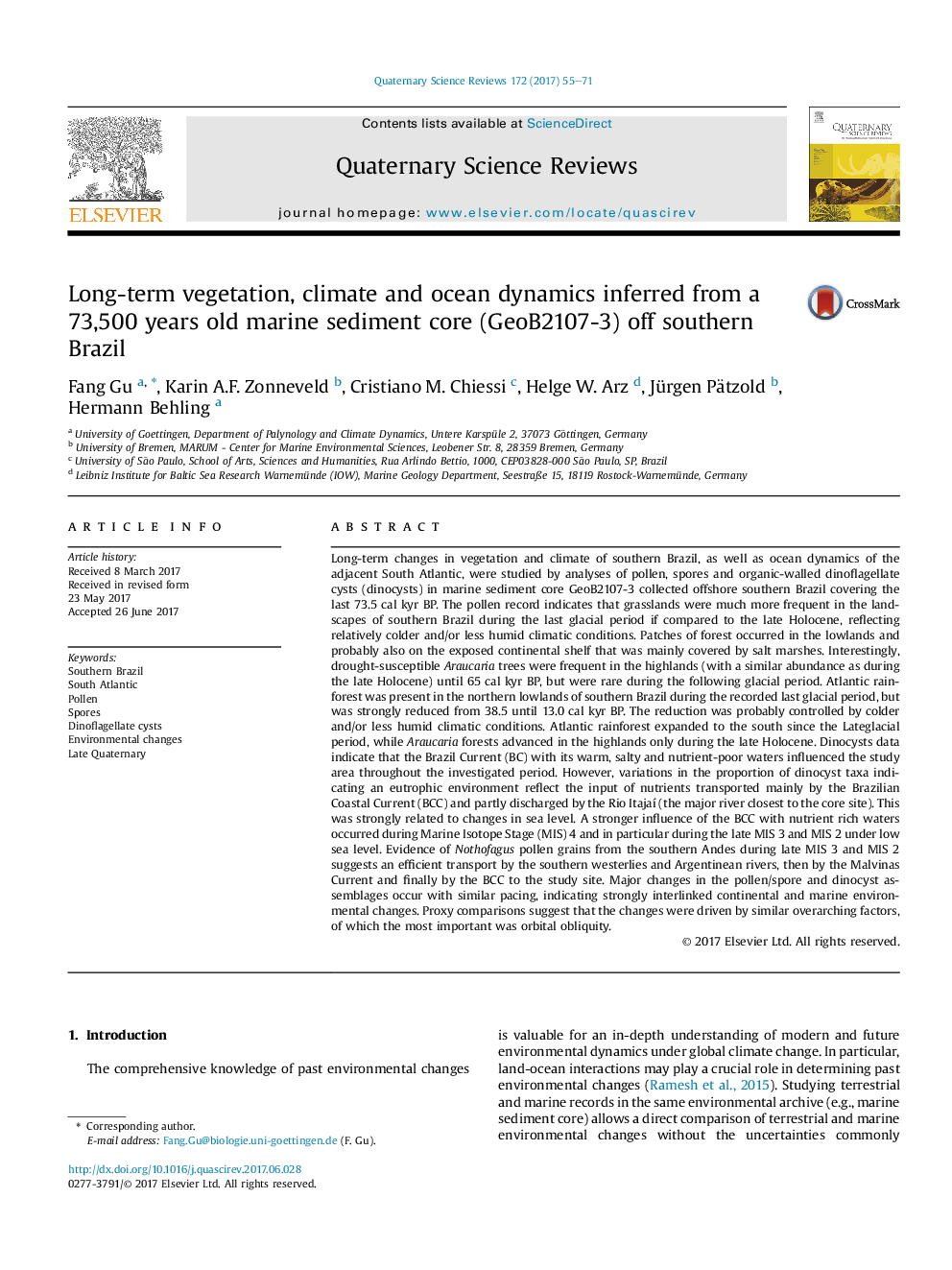| کد مقاله | کد نشریه | سال انتشار | مقاله انگلیسی | نسخه تمام متن |
|---|---|---|---|---|
| 5786550 | 1640763 | 2017 | 17 صفحه PDF | دانلود رایگان |
عنوان انگلیسی مقاله ISI
Long-term vegetation, climate and ocean dynamics inferred from a 73,500 years old marine sediment core (GeoB2107-3) off southern Brazil
دانلود مقاله + سفارش ترجمه
دانلود مقاله ISI انگلیسی
رایگان برای ایرانیان
کلمات کلیدی
موضوعات مرتبط
مهندسی و علوم پایه
علوم زمین و سیارات
زمین شناسی
پیش نمایش صفحه اول مقاله

چکیده انگلیسی
Long-term changes in vegetation and climate of southern Brazil, as well as ocean dynamics of the adjacent South Atlantic, were studied by analyses of pollen, spores and organic-walled dinoflagellate cysts (dinocysts) in marine sediment core GeoB2107-3 collected offshore southern Brazil covering the last 73.5 cal kyr BP. The pollen record indicates that grasslands were much more frequent in the landscapes of southern Brazil during the last glacial period if compared to the late Holocene, reflecting relatively colder and/or less humid climatic conditions. Patches of forest occurred in the lowlands and probably also on the exposed continental shelf that was mainly covered by salt marshes. Interestingly, drought-susceptible Araucaria trees were frequent in the highlands (with a similar abundance as during the late Holocene) until 65 cal kyr BP, but were rare during the following glacial period. Atlantic rainforest was present in the northern lowlands of southern Brazil during the recorded last glacial period, but was strongly reduced from 38.5 until 13.0 cal kyr BP. The reduction was probably controlled by colder and/or less humid climatic conditions. Atlantic rainforest expanded to the south since the Lateglacial period, while Araucaria forests advanced in the highlands only during the late Holocene. Dinocysts data indicate that the Brazil Current (BC) with its warm, salty and nutrient-poor waters influenced the study area throughout the investigated period. However, variations in the proportion of dinocyst taxa indicating an eutrophic environment reflect the input of nutrients transported mainly by the Brazilian Coastal Current (BCC) and partly discharged by the Rio Itajaà (the major river closest to the core site). This was strongly related to changes in sea level. A stronger influence of the BCC with nutrient rich waters occurred during Marine Isotope Stage (MIS) 4 and in particular during the late MIS 3 and MIS 2 under low sea level. Evidence of Nothofagus pollen grains from the southern Andes during late MIS 3 and MIS 2 suggests an efficient transport by the southern westerlies and Argentinean rivers, then by the Malvinas Current and finally by the BCC to the study site. Major changes in the pollen/spore and dinocyst assemblages occur with similar pacing, indicating strongly interlinked continental and marine environmental changes. Proxy comparisons suggest that the changes were driven by similar overarching factors, of which the most important was orbital obliquity.
ناشر
Database: Elsevier - ScienceDirect (ساینس دایرکت)
Journal: Quaternary Science Reviews - Volume 172, 15 September 2017, Pages 55-71
Journal: Quaternary Science Reviews - Volume 172, 15 September 2017, Pages 55-71
نویسندگان
Fang Gu, Karin A.F. Zonneveld, Cristiano M. Chiessi, Helge W. Arz, Jürgen Pätzold, Hermann Behling,